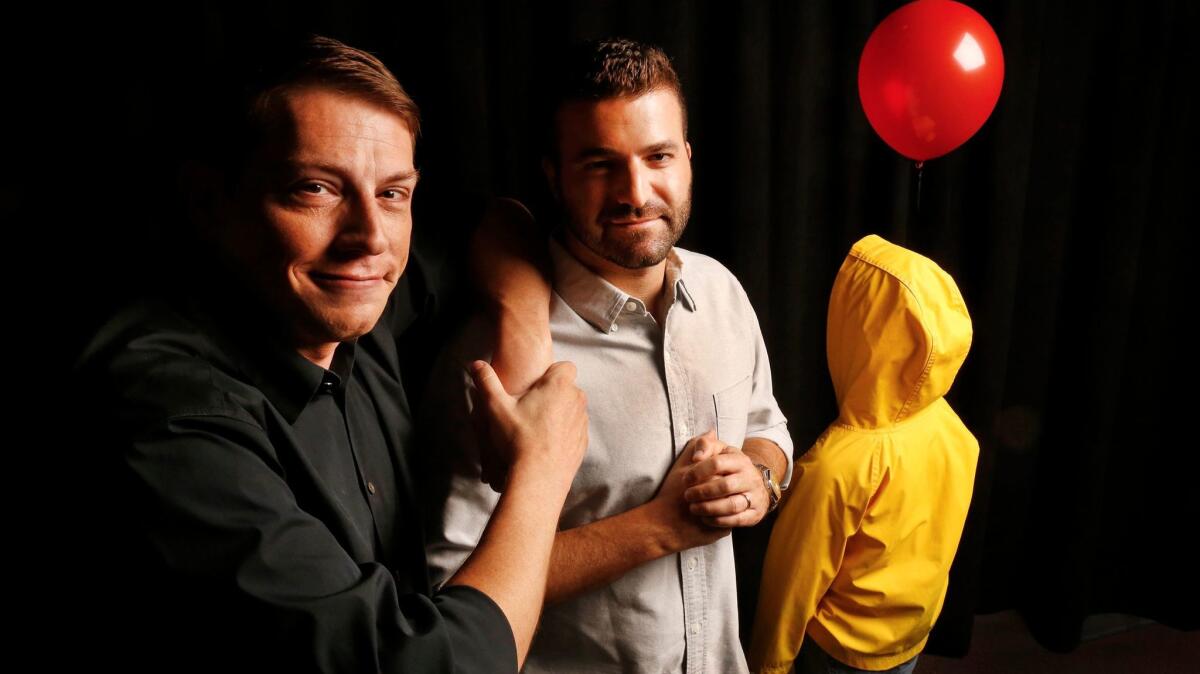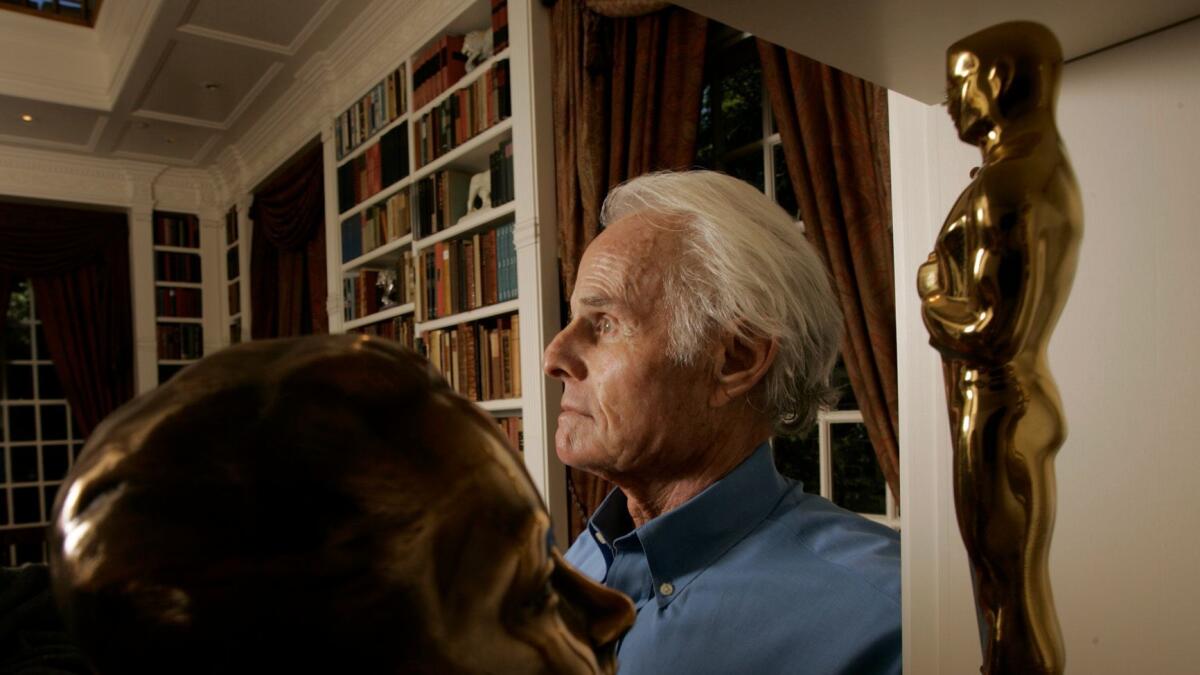The making of a monster hit: How ‘It’ could change the way Hollywood makes movies

- Share via
The Beverly Hills offices of KatzSmith Productions are filled with the kind of treasures one would expect from the company that helped create “It,” currently the highest-grossing horror film of all time at the global box office.
Haunting the conference room is an immense cineplex standee for “Abraham Lincoln: Vampire Hunter,” the 2012 film made from the mash-up novel by Seth Grahame-Smith, who partnered with David Katzenberg to form KatzSmith.
The S.S. Georgie, the paper boat whose maiden voyage into a sewer led to the gruesome death of the tiny owner in “It,” is perched atop a first edition of the Stephen King book that inspired it all. A “Keep Calm and Carry On” sign, among the “E.T.” and “MacGruber” posters, is marred with blood splatters so it just says “Keep Calm.”
But perhaps the most intriguing item that adorns the walls of the work space is the portrait of Dick Zanuck, the man who produced “Jaws,” “The Sting,” “Cocoon” and helped propel the careers of Tim Burton and Steven Spielberg. Hanging directly in front of Grahame-Smith’s desk, Zanuck is pictured under the exaggerated gothic umbrella from the 2012 Burton remake of “Dark Shadows.” It’s the prop from what could arguably be described as Grahame-Smith’s first commercial and critical stumble.
“I learned more about producing from Dick Zanuck in two years than I probably realize,” Grahame-Smith says, motioning to the framed image. “He was old school, a capital P producer, the likes of which don’t really exist anymore. He believed in getting right to the point when there was bad news, not dancing around it. He also had this line, ’A good producer has the director and the studio convinced that they’re his best friend.’”
“I asked him about this script once,” Grahame-Smith continues. “It wasn’t mine, thank God. He had read the script on a flight back from London, and Dick said, ‘If I had been on a boat, it would have been in the bottom of the Atlantic!’”

The margins are shrinking. The budgets are shrinking. ... Gone are the days of 16 producers on a movie who are just keeping the phones hot.
— Seth Grahame-Smith, co-founder KatzSmith Productions
“Some of the stuff he said reminds me of my dad, in that he was brutally, brutally honest,” Katzenberg says, referring to his own Hollywood legacy. His father is former DreamWorks co-founder and current WndrCo co-creator Jeffrey Katzenberg. “[Zanuck] was a master at making everyone his best friend and serving as that punching bag for the studio so [the director] would never feel it and never know.”
Just a few days before the colossal success of “It,” Grahame-Smith and Katzenberg have opened the doors of their production company to talk about the future of genre movie-making — or at least the future as they see it.
Certainly they see the business of Hollywood shifting away from the old days, “contracting” to use their words. It’s harder to get movies made, period.
“The margins are shrinking,” Grahame-Smith explains. “The budgets are shrinking. The returns are shrinking, and so gone are the days of 16 producers on a movie who are just keeping the phones hot, the studio informed and sitting on set eating craft services. You can’t support that anymore.”
That’s where Katzenberg, with extensive directing credits in TV, and Grahame-Smith, with his multiple writer credits, suggest their director/writer combination gives them a leg up on the old guard. They know the realities of tabulating hot costs, daily dealings with the studios and other producer duties, but they’re ready and willing to throw a camera over their shoulder as well. True, the idea of a hands-on producer is enough to make some directors curl up into the fetal position, and neither of them suspect they’ll be using their style of producing on a Chris Nolan picture anytime soon. But it worked for “It” and director Andy Muschietti.
They contend that the future of Hollywood is much more fluid. They cite Seth Rogen and Evan Goldberg — and even Phil Lord and Chris Miller (despite the “Star Wars” dust-up) — as creators they admire. All came up in the collaborative world of TV, as did Grahame-Smith and Katzenberg.
The two first met in November 2006 when CBS was seeking content creators for its then-fledgling digital division.
Together they worked on the little-known comedy series “Clark and Michael,” created by and starring Clark Duke and Michael Cera, plus a cast of now-beloved comedians including “Veep’s” Tony Hale. In 2010 they co-created MTV’s first scripted series, “The Hard Times of RJ Berger,” which kicked off KatzSmith Productions.
Meanwhile, Grahame-Smith got his geek bona fides writing the novel “Pride and Prejudice and Zombies,” which would land him on Burton’s radar, while Katzenberg built his resume directing TV including “Awkward” and “The Goldbergs.” But whispers about KatzSmith Productions didn’t really kick up until it started getting attached to the treasured horror staples from the past. Suddenly there was talk of “Beetlejuice 2” and “Gremlins 3,” because nothing sets off the internet like news of a remake. So far, though, the only fabled re-imagining to debut is “It.” The movie was such a huge success, the sequel was announced 17 days after the Sept. 8 release.
If horror could have a little bit bigger canvas, I think you’re going to get some great movies out of it.
— Seth Grahame-Smith, co-founder KatzSmith Productions
First approached by co-producers Dan Lin and Roy Lee (who had the rights to King’s novel), the original idea was that Katzenberg could direct and Grahame-Smith would write. Then director Cary Fukunaga reached out.
“We were developing a script with Cary and his writing partner,” says Grahame-Smith. “During that process ‘True Detective’ comes out, and of course, we all look like geniuses.”
But Fukunaga’s “It” never materialized — New Line and Fukunaga parted ways three weeks before production.
“It was truly creative differences,” Grahame-Smith says. “It wasn’t about personality. It wasn’t about budget. Cary gave us a script that became the basis of a great movie that we made.”
“Yes, the tone was a little different,” Katzenberg says of Fukunaga’s vision. “Yes, it was a little darker. … That’s very hard to do in the studio system.”
A parade of directors followed, many with complex look books and elaborate sketches of “It’s” bloody clown Pennywise. But it was “Mama” director Muschietti’s ideas on a few napkins and Post-It notes that sealed the deal.
“He started with the Losers,” says Grahame-Smith, referring to “It’s” misfit kids who form the Losers Club. “[Muschietti] started talking about himself as a 13-year-old loser in Argentina, reading a translation of this 1,100-page book as a kid and what it meant to him.”
Although the KatzSmith partners push for a collaborative workplace and are more than willing to pitch in with dialogue rewrites or even helping construct a set, both are adamant about giving credit where it’s due.
“[‘It’] has one director,” Katzenberg says. “I’m a director as well, but I’m on this movie to service Andy and to be his producer.” Both producers echoed their intent to protect Muschietti’s vision and remain helpful where they could.
“A lot of the time,” Grahame-Smith says, “we would set something up, and Andy would come in and go, ‘No.’”
“It” standout Finn Wolfhard — known for his improvisational, scene-stealing cuss-outs as Losers Club member Richie Tozier — can attest to the on-set atmosphere described by the producers.
“That’s why the improv worked out so well,” Wolfhard says over the phone, “because Seth and David were helping out, too. We’d see a line that didn’t really work … and we’d use this little writers room and brainstorm what we could say. They keep you on your toes. They’re comedy writers and directors at the same time, so they get it.”
What does “It’s” success mean for the future of horror? They both hope to see the continuation of middle-budget horror movies. “Not just Stephen King adaptations,” Grahame-Smith says, “but if horror could have a little bit bigger canvas, I think you’re going to get some great movies out of it.”
Despite their desire change Hollywood’s perception of the producer, they’re not it willing to neglect the lessons from the past, including the words of Zanuck who called Grahame-Smith the day before he died.
“He said, ‘Sethie, why aren’t we doing something together? Let’s catch up. Let’s have lunch.’ Still hustling and still trying to put movies together. It was very inspiring. I keep that picture there as a reminder of that. Sometimes you can sit here and bang your head on the desk, and you look up, and there’s Dick. I love that he’s got the umbrella over his head. I look at that, and I think he’s just weathering the storm. That’s what he did. That’s what a producer does. They weather the storm.”

A thousand “scare-actors” a night wend through an assembly line of gore, where they are transformed into terrifying characters for Universal Studio’s Halloween Horror Nights.

Universal Studios pulls out the knives, axes and pig heads to scare you silly
Twitter: @MdellW
MORE HORROR
The Pennywise presidency and why horror is the movie genre of the moment
Why this film critic won’t see any more horror movies
The ‘American Horror Story’ cast gets a taste of its own medicine at Roanoke maze
TV horror vs. movie horror: Guillermo del Toro on telling scary stories across different mediums
A timeline of horror movies and moments
More to Read
The biggest entertainment stories
Get our big stories about Hollywood, film, television, music, arts, culture and more right in your inbox as soon as they publish.
You may occasionally receive promotional content from the Los Angeles Times.











